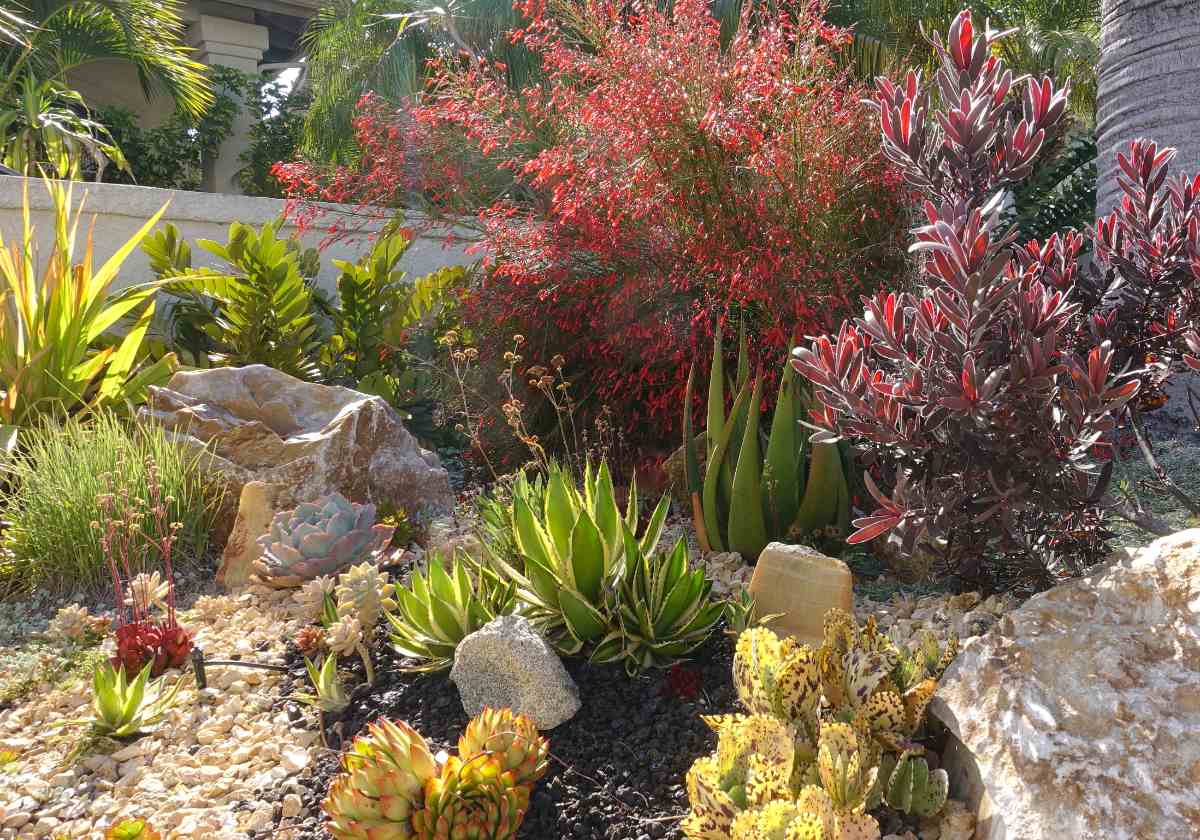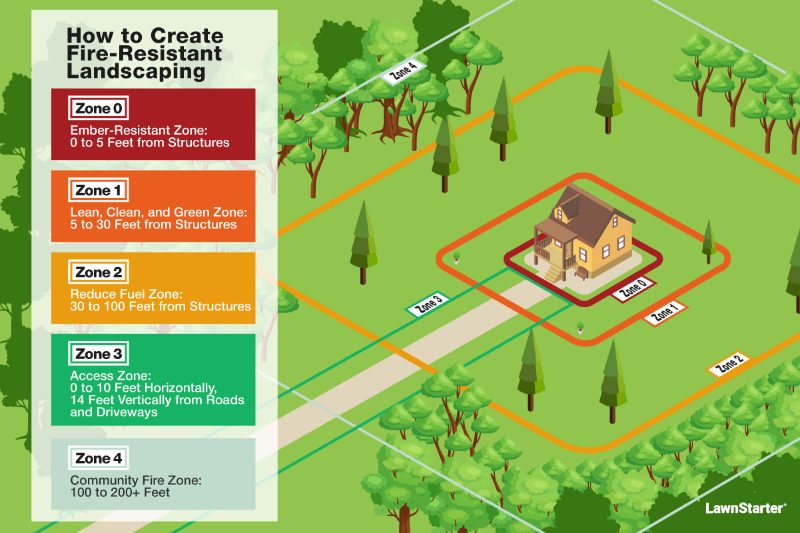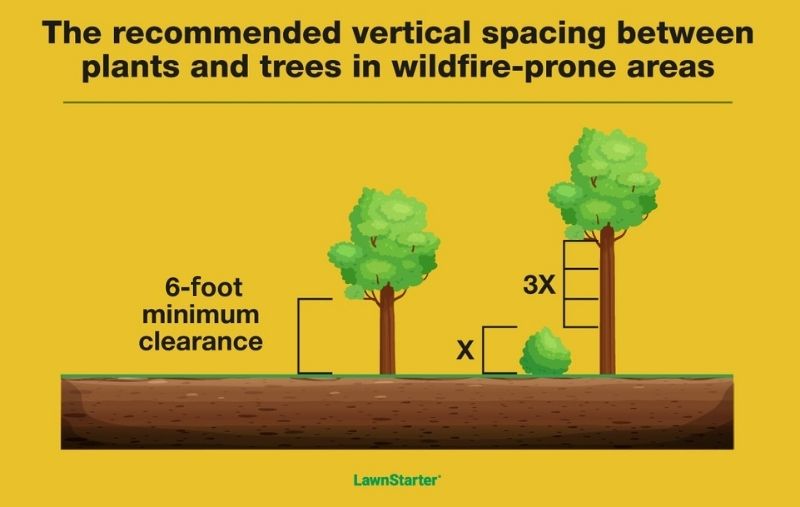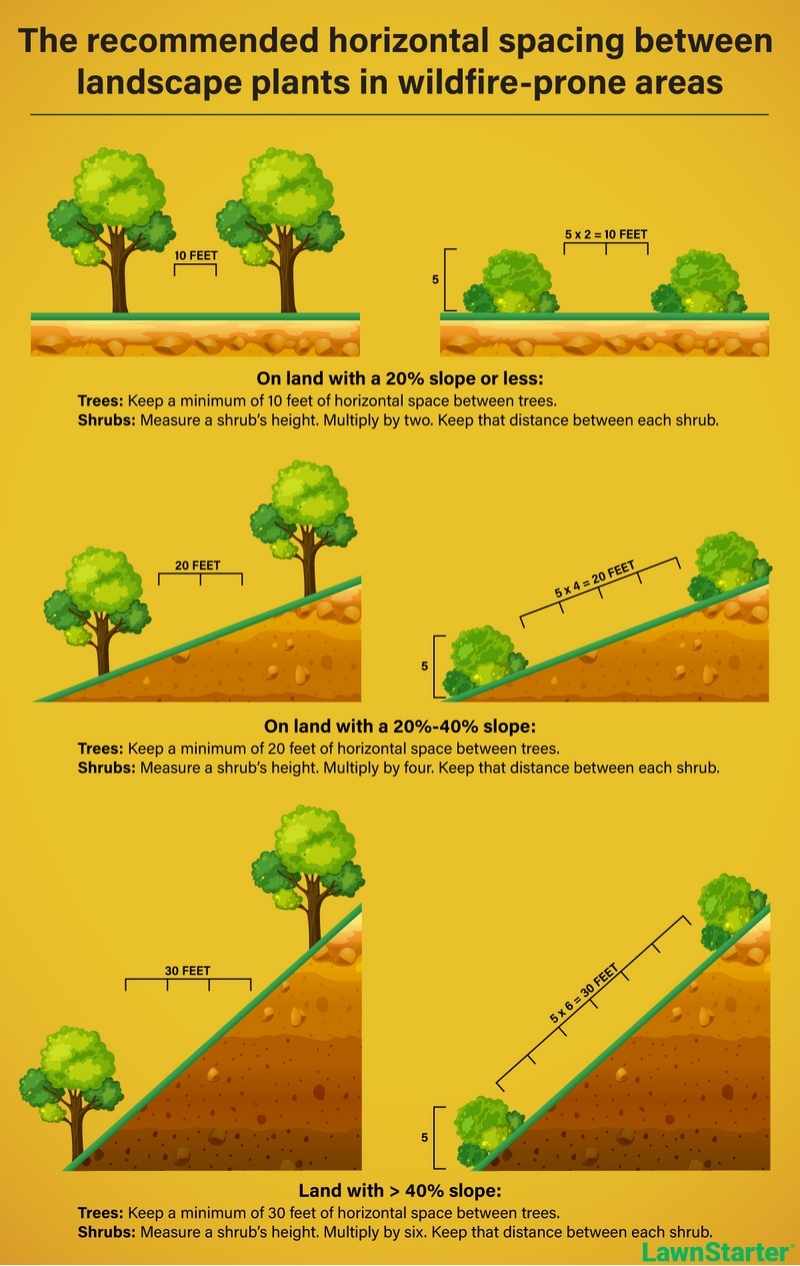
As wildfires become increasingly frequent and destructive across the United States, creating fire-resistant landscaping has become an essential safety strategy for many.
Fire-resistant landscaping — also known as firescaping — combines thoughtful plant selection, strategic design principles, and proactive maintenance to create a defensible space that can slow or stop the spread of wildfires and preserve your home.
Understand and Create Zones of Defensible Space
Defensible space is a buffer zone created around your home and other buildings to slow or stop wildfire spread. It’s a fire protection strategy that gives your home a better chance of surviving a wildfire. It also provides firefighters a safer area to defend your property.
The concept works by managing vegetation and reducing fuel to interrupt a fire’s path. Rather than having continuous flammable materials leading right up to your house, defensible space creates gaps and reduces fire intensity as it approaches structures.
In many places with high wildfire risk, defensible space is required by local laws!
Defensible space is typically divided into 3 different zones, moving outwards from your house or other buildings. Some areas of California have 5 zones to account for roadways and community spaces. The names and numbers of the defensible space zones may differ among fire agencies. However, the underlying principles within this “Home Ignition Zone” are typically the same.
To help you create defensible space around your home, hire a local landscaping professional to get your home wildfire-ready.

My Tip: Consult your local fire department or fire protection district for specific local ordinances, as they can often be stricter than state laws.
Zone 0: 0 to 5 Feet from Structures
Also known as “Zero Zone,” “Immediate Zone,” “Ember-Resistant Zone” (Cal Fire), or “Non-Combustible Zone” (Idaho Firewise).
Goal: Eliminate materials that can directly spread fire to structures.
The Immediate or Zero Zone extends from your home’s exterior walls, decks, and other attached structures out to 5 feet. It is your most critical defense area, where the goal is to eliminate flammable materials.
Statistics show that flying embers ignite 60% to 90% of homes, many of which have traveled on the wind for many miles. With that in mind, nothing (i.e., zero) that can ignite from embers should be placed, planted, or allowed to accumulate within the Zero Zone.
Zone 0 Guidelines:
- Use gravel instead of combustible mulch.
- Create walkways with pavers or concrete.
- Opt for minimal plantings.
- Use only the most fire-safe plants.
- Replace wooden fences and gates with fire-resistant materials like metal or vinyl.
- Move firewood (and other lumber) to Zone 2.
- Store propane tanks and gasoline cans in Zone 2.
- Consider storing waste canisters, boats, and vehicles in Zone 1 or 2.
- Remove woody vegetation and climbing vines.
- Choose furniture made of metal, stone, or fire-resistant materials.
- Do not use furniture cushions or door welcome mats.
- Maintain 10 feet of clearance between branches and stovepipes or chimneys.
- Trim branches so they do not encroach into the zone.
- Clear debris from gutters, roofs, and under decks.
Zone 1: 5 to 30 Feet from Structures
Also known as “Intermediate Zone,” “Lean, Clean, and Green Zone” (Cal Fire), or “Pruned and Groomed” (Idaho Firewise).
Goal: Reduce fire intensity as it nears structures through fuel reduction.
The Intermediate Zone creates a managed transition area that has more diverse landscaping while maintaining fire safety. In this space, wildfire mitigation focuses on creating fuel breaks between plant groupings and selecting fire-resistant species. You’re trying to limit fuel and reduce the fire’s intensity as it gets closer to your home.
Zone 1 Guidelines:
- Plant fire-resistant plants in small, irregular clusters instead of large masses.
- Use non-combustible materials to create breaks between vegetation.
- Maintain 10 feet of space between trees, shrubs, and flammable materials like play structures.
- Prune plants and shrubs back from windows.
- Avoid using landscape fabric.
- Remove ladder fuel under trees. (See Follow Fire-Resistant Landscaping Design Principles for more information.)
- Do not store lumber or old tires in this zone.
- Clean vegetation from under trees.
Zone 2: 30 to 100 Feet from Structures
Also known as “Extended Zone,” “Reduce Fuel Zone” (Cal Fire), or “Pruned and Groomed and Leading to Natural Vegetation” (Idaho Firewise).
Goal: Reduce the fuel loading and fuel continuity to keep the fire on the ground.
The Extended Zone focuses on reducing fire intensity and slowing its approach toward your property. The exact distance depends on your slope — steeper slopes require greater distances since fire travels faster uphill.
Zone 2 Guidelines:
- Maintain adequate vertical and horizontal spacing between trees and shrubs.
- Keep a 10-foot radius of bare soil or gravel around wood piles, outbuildings, and propane tanks.
- Debris such as pine needles, small branches, and fallen leaves is permitted up to a 3-inch depth.
- Remove all dead or dying trees and shrubs.
Zone 3: 0 to 10 Feet Horizontally, 14 Feet Vertically from Roads and Driveways
Also known as the “Access Zone” (Cal Fire) or “Roadside Zone”
Goal: Maintain evacuation routes and access for first responders.
As a property owner, you are also responsible for maintaining the vegetation adjacent to roads and driveways. Create at least 10 feet of outward clearance from the edge of roads and driveways, and 14 feet overhead clearance. This clearance allows homeowners to evacuate safely and first responders to access homes if needed.
Zone 4: 100 to 200+ Feet
Also known as the “Community Zone” (Cal Fire)
Goal: Prevent the rapid movement of fire within communities.
Many times, there isn’t 100 feet between structures and parcel lines, making it necessary to work with your neighbors to create defensible space that protects multiple properties. Sometimes you may need to gain permission from a neighbor to clear defensible space to protect your home.
Choose Fire-Resistant Plants
Don’t worry, creating a defensible space doesn’t have to be drab and boring. There are plenty of colorful, aesthetically pleasing fire-resistant plants you can incorporate into your landscaping.
One of the most important things to remember is that fire-resistant plants are not completely fireproof, nor are they bulletproof. By definition, fire-resistant plants do not readily ignite, and in the event they do, they produce fewer embers.
They can still be severely damaged or even killed by a wildfire. However, when maintained well, they won’t add to the intensity of a wildfire or encourage it to spread if they do ignite.
When looking for fire-resistant plants, look for ones with these characteristics:
- Leaves and stems that retain or store moisture.
- Smooth leaf surfaces rather than fuzzy or hairy textures.
- Plants with extensive, deep root systems.
- Excellent drought tolerance.
- Have low levels of volatile oils, resins, and waxy substances.
- An open-growth habit versus dense growth.
- Don’t drop excessive amounts of combustible bark, leaves, or twigs.
See Related: Fire-Resistant Landscaping Plants
My Tip: I’m a huge fan of native plants, so if you can incorporate them into your firescaping, fantastic! However, it’s essential to verify if they are fire-resistant. If you opt for non-natives, look for ones that aren’t invasive, so they stay within their intended space. For help with choosing plants, ask your local Cooperative Extension Office for a state-specific fire-resistant plant bulletin.
Follow Fire-Resistant Landscaping Design Principles
When planting, proper plant spacing in both vertical and horizontal directions is crucial for wildfire safety. Creating adequate gaps between vegetation stops fires from climbing upward through trees (known as laddering), which can lead to dangerous canopy or crown fires.
Canopy fires are particularly hazardous because they spread rapidly from tree crown to tree crown, especially when windy. These elevated fires are more intense and more challenging to fight than when the fire is on the ground.
Vertical Spacing

- Trim branches at least 6 feet off the ground.
- Maintain adequate spacing between the tops of shrubs and overhanging tree branches: multiply shrub height by 3 for clearance.
Horizontal Spacing

Proper horizontal spacing helps keep fires from spreading to one bush or tree to another, but the spacing between trees and shrubs depends on the slope of the land.
| Slope | Minimum Space Between Trees | Minimum Space Between Shrubs |
| 20% or less | 10 feet | Shrub height * 2 |
| 20% to 40% | 20 feet | Shrub height * 4 |
| Over 40% | 30 feet | Shrub height * 6 |
To make things easy on yourself, hire a bush trimming pro from LawnStarter to maintain proper vertical and horizontal spacing around your home.
Add Hardscaping Elements for Fire Protection
Hardscaping is a game-changer for fire-resistant landscaping — especially in Zone 0 — because it creates natural firebreaks that stop flames in their tracks. Think gravel pathways, brick patios, and concrete walkways around your home’s perimeter — these non-combustible features give embers nowhere to catch and spread.
Hardscape elements, such as retaining walls, flagstone steps on hills, and water features, serve multiple purposes. They provide beautiful outdoor living spaces while creating multiple defensive barriers that protect your home and offer firefighters safer access points.
Properly Maintain Your Landscaping
Regular maintenance is essential to keep defensible space effective. Without maintenance, plants can grow too close together or accumulate flammable debris. When that happens, it negates the intended purpose of a defensible space.
- Keep plants and grass well-watered. Soak them deeply once or twice a week to encourage deep root growth and improved drought tolerance. Deeply water trees and shrubs every 3 to 4 weeks.
- Prune out any dead or dying branches.
- Trim low-hanging branches.
- Deadhead spent blossoms.
- Prune trees and shrubs to maintain correct vertical and horizontal spacing.
- Consider drip irrigation for watering plants and trees.
- Audit your irrigation system every spring.
- Remove weeds, invasive plants (especially grasses), and overgrown brush.
- Keep turfgrass mowed to 3 to 4 inches tall, and native grasses under 6 inches.
| While you’re busy creating your defensible space, have a LawnStarter pro mow your lawn. Homeowners pay $48, on average, for a pro to mow their grass. |
FAQ About Creating Fire-Resistant Landscaping
Fire-resistant landscaping costs vary greatly depending on the scope of the project, the area where you live, and whether you choose the DIY or professional route.
Regarding specifics, though, if you decide to replace wooden mulch with pea gravel, expect to pay about $46 per cubic yard, and a sprinkler system costs $0.29 to $0.48 per square foot for an above-ground system, depending on the number of zones, type of sprinkler heads, etc.
Yes, many insurance carriers will give homeowners discounts for implementing defensible space measures and fire-resistant landscaping. The availability and amount vary depending on the insurer and state.
Like cost, the timeline varies greatly depending on the project’s scope. You can replace wood mulch with rocks, clean up brush piles, and trim back overgrown vegetation within a few days. An irrigation system may take a couple of weeks to install, and it could take a full growing season to create proper spacing between plants. Establishing fire-resistant plants and trees can take years, if not decades.
Turn to Experts for Firescaping Help
If you need help designing or maintaining your defensible space, contact LawnStarter, and we’ll put you in touch with a local landscaping professional. These pros create defensible spaces around their own homes and those of clients, so they’re well equipped to help you reach your firewise landscaping goals.
Sources:
- “Fire-Resistant Plants for Home Landscapes.” By Amy Jo Detweiler, Stephen Fitzgerald, Ariel Cowan, Neil Bell, and Thomas Stokely. Oregon State Extension Service.
- “Fire Resistant Landscaping.” By Allison Kosto, MSU Broadwater County Extension Agent. Montana State University.
- “Protect Your Home & Property from Wildfire.” Colorado State Fire Service.
- “Fire Resistant Landscapes.” Idaho Firewise.
Main Image Credit: Simone / Adobe Stock